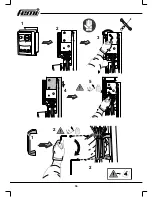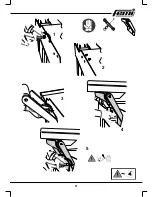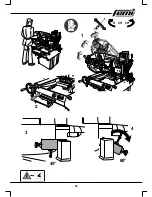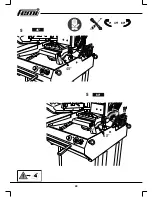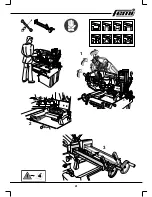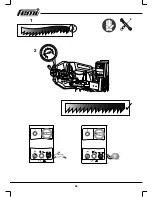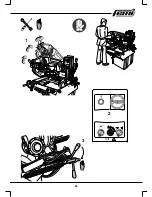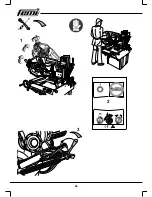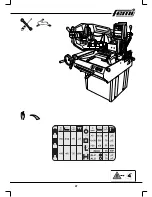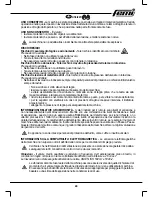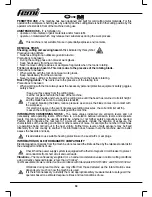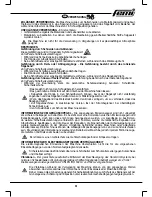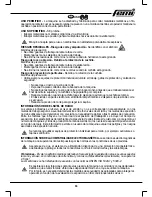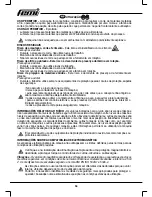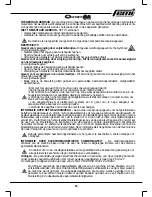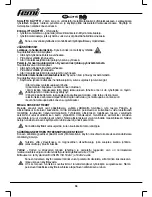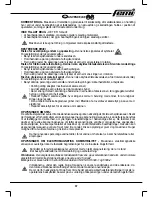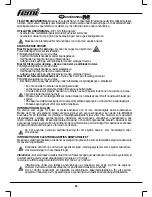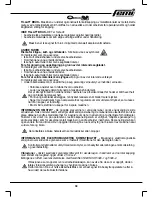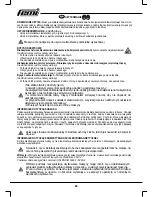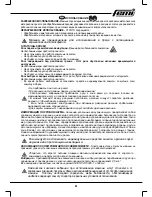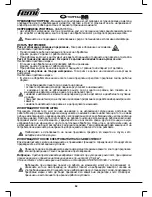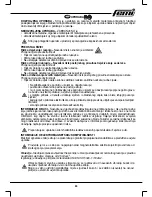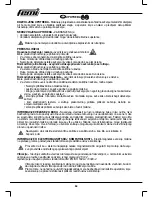
50
EN
USE
PERMITTED USE -
The machine has been designed and built for cold cutting metal materials. For this
operation the workpiece is held in place by a clamp and the cutting blade is held in the cutting position by the
operator who stands in front of the machine during use.
UNINTENDED USE -
IT is forbidden to:
• operate on non-metals, organic materials and/or food stuff s.
• operate on materials which may release toxic substances during the work process.
This machine is not suitable for use in potentially explosive environments.
RESIDUAL RISKS
Shearing, cutting and severing hazard -
Risk indicated by this symbol:
Precauzioni da adottare
• Nella fase di taglio non utilizzare guanti da lavoro.
Precautions to be taken
• During the cutting phase do not wear work gloves.
• Keep hands away from the work area.
• Never remove cutting residues or workpiece fragments when the tool is rotating.
Friction or abrasion hazard - This risk is due to the presence of the rotating blade.
Precautions to be taken
• When working with the tool do not wear work gloves.
• Keep hands away from the work area.
• Never remove cuttings or fragments from the machine when the blade is rotating.
Risk of fl ying debris -
This risk is due to the presence of the rotating tool.
Precautions to be taken
• When working with the tool, always wear the necessary personal protective equipment: safety goggles,
safety shoes.
• Keep your face away from the cutting area;
• Let the cut piece fall onto the base of the machine;
• Never bring hands anywhere near the cutting zone until the head has returned to its full height
and the blade has come to a complete standstill;
• To avoid breaking the blade, reduce pressure as soon as the blade comes into contact with
the workpiece;
• for electronic saws, in the event of excessive cutting pressures, the current limiter will trip.
• Lessen the cutting pressure to safeguard the machine.
INFORMATION CONCERNING NOISE -
The noise values indicated are emission levels and not
necessarily safe operating levels. While there is a correlation between emission levels and exposure
levels, this cannot reliably be used to determine whether or not further safety precautions are needed.
Factors which infl uence the real level of a worker's exposure include the duration of exposure, the
characteristics of the working environment, other sources of noise, for example the number of machines
or operations being carried out in the near vicinity. Furthermore, levels of safe exposure may be fi xed
diff erently from one country to another. This information does however help the machine user to better
assess the hazards and risks.
It is advisable to use suitable hearing protection such as earmuff s or ear plugs.
INFORMATION ON ELECTROMAGNETIC COMPATIBILITY
Electromagnetic emissions from the machine do not exceed the limits defi ned by the relative standards for
the envisaged conditions of use.
Check that the power supply system is equipped with a thermomegnetic circuit breaker to protect
all conductors from short circuit and overloads.
Vibrations
-
The mean frequency-weighted r.m.s. hand-arm acceleration value in normal cutting conditions
using correctly sharpened blades, is less than 2.5 m/sec
2
.
Test measurements were carried out in accordance with Standards EN ISO 5349-1 and EN ISO 5349-2.
Vibrations during real machine use may diff er from those declared as the total vibration value
depends very much on how the machine is used.
It is therefore necessary to identify the most appropriate safety measurements to safeguard the
operator based on estimated exposure times and real conditions of use.
Summary of Contents for N310 DADG
Page 12: ...12 1 10 15 9 9 6 17 3 14 2 4 7 8 11 5 12 13 16...
Page 20: ...20 23 22 18 20 21 A B 19...
Page 21: ...21 3 1 2 4 5 6...
Page 22: ...22 1 2 3 4 A A...
Page 23: ...23...
Page 27: ...27...
Page 29: ...29...
Page 30: ...30 B B...
Page 31: ...31 800 mm 800 mm 800 mm 800 mm...
Page 32: ...32 2000 mm 2000 mm...
Page 33: ...33...
Page 34: ...34 1 2 2 4 5 3 3 6...
Page 35: ...35 1 2 2 3 3...
Page 36: ...36 3 3 1 1 2 2 1 1 2 2 2 2 4 4 5 5...
Page 37: ...37 1 1 2 2 3 3 4 4 5 5...
Page 38: ...38 1 60 15 0 60 30 45 15 30 2 3 3 0 45 60...
Page 39: ...39 0 45 60 1 3 4 60 15 0 60 30 45 15 30 2 45 60...
Page 40: ...40 45 0 45 60 60 60 15 0 60 30 45 15 30 45 45 5 60 15 0 60 30 45 15 30 45 60 5...
Page 41: ...41 1 2 3...
Page 42: ...42 4 60 15 0 60 30 45 15 30 5 6 7 45...
Page 43: ...43 1 2 2 3...
Page 44: ...44 1 3 2 L H L H...
Page 45: ...45 1 3 L H 2...
Page 46: ...46 L H 1 3 2...
Page 47: ...47...
Page 61: ...61 RU 2 5 2 UNI EN ISO 5349 1 5349 2...
Page 62: ...62 BG 2 5 2 UNI EN ISO 5349 1 5349 2...
Page 65: ...65 EL 2 5 m sec 2 UNI EN ISO 5349 1 5349 2...
Page 75: ...75...
Page 76: ...76 1 2 1 L H 3 4...
Page 77: ...77 5 9 1 ON OFF ON OFF 13 0 15 14 12 11 10 9 1 8 2 6 7 8...
Page 78: ...78 ON OFF ON OFF 11 10 1...
Page 79: ...79 2 1 2 3 4 5...
Page 80: ...80 L H 6 2 7 8 ON OFF ON OFF 13 0 15 14 12 11 10 9 1 8 2...
Page 81: ...81 9 ON OFF ON OFF 2 10 11...
Page 82: ...82 3 OFF 400 V 50 Hz ON...
Page 92: ...92...
Page 93: ...93 0...
Page 94: ...94 1 1 2 3 4...
Page 95: ...95 ON OF F ON OFF 1 5 5 6 6 9 10 7 8 5 5...
Page 96: ...96 2 1 2 3 4...
Page 97: ...97 6 6 6 5 5 7 6 2...
Page 114: ...114 RU 1 2 3 4 1 2 3 4 1 2 3 1 2 3 0 45 1 26 1 1 2 3 4 5 1 2 3 4 5 1 2 1 2 1 2 1 2...
Page 115: ...115 BG 1 2 3 4 1 2 3 4 1 2 3 1 2 3 0 45 1 26 1 1 2 3 4 5 1 2 3 4 5 1 2 1 2 1 2 1 2...
Page 118: ...118 EL 1 2 3 4 1 2 3 4 1 2 3 1 2 3 0 45 1 26 1 1 2 3 4 5 1 2 3 4 5 1 2 1 2 1 2 1 2...
Page 128: ...128...

